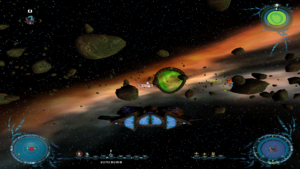Sinistar Unleashed: The Learning Curve Strikes Back!
Not much progress to report today. I’m still trying to become sufficiently proficient with the flightstick to tackle the highest level I’ve reached without it. I still maintain that it will be a benefit to me once I’ve mastered it, but right now, it’s a learning curve. It strikes me that the game’s ideal player is one who’s already over this hurdle, just as, say, Animal Well is built on the assumption that you’ve already mastered basic platforming skills. It’s a game for people who have graduated from the likes of Wing Commander and are seeking something more involving, more complex.
I’ve been replaying from the beginning, on Easy, and in the process I’ve seen some Sinistars that I had previously passed over by destroying the gate. For what it’s worth, I don’t consider replaying from the beginning to be all that much of a setback; this is a game that’s positively designed to be replayed from the beginning. But being worse at the controls means that I kill fewer worker drones, which makes it less likely that I’ll destroy the gate before the Sinistar shows up. And some of them are real toughies, ones that I have no idea how to even begin to approach. There’s one that’s surrounded by a flickering green spherical force field, and sometimes it projects force fields at you, sending you hurtling away as speeds sufficient to destroy you if you collide with anything. Even in Easy mode, I don’t know how to survive that encounter long enough to do the kind of experimentation needed to figure out how to so much as scratch its paint.
I’d gladly read a walkthrough for some of these guys, but there doesn’t seem to be one online, even at old mainstays like GameFAQs that host hits going back to the dawn age. It just never had a sufficiently large fanbase to produce one. I guess that’s what happens when your target audience is the intersection of “nostalgic for 80s coin-op games” and “proficient with a flightstick”.
 Comments(0)
Comments(0)